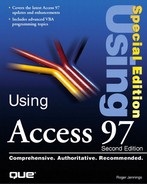Chapter 23. Working with Structured Query Language
This chapter describes Structured Query Language (SQL), the structure and syntax of the language, and how Access translates queries you design with Access's graphical query-by-example (QBE) technique into SQL statements. A SQL background helps you understand the query process and design more efficient queries. Knowledge of SQL syntax is necessary to use the new sub-query and UNION query capabilities introduced by Access 2.0 and for many of the applications you write in Access VBA. Examples of SQL have been presented in other chapters in this book. These examples—usually figures that illustrate a SQL statement created by Access—demonstrate what occurs behind the scenes when you create a query or a graph.
Note
There are no significant differences between the Access 2.0, Access 95, and Access 97 versions of SQL, previously known as Access SQL. The new name for Access SQL is Microsoft Jet Database Engine SQL, called Jet SQL in this book for brevity. The primary additions to Access SQL occurred during the upgrade from Access 1.1 to Access 2.0. The new Jet SQL terminology is more appropriate than Access SQL, because all members of Microsoft Office, Visual Basic, and any other application that supports VBA can use the Jet database engine.
